oracle 12c ocm考试范围
- 格式:docx
- 大小:16.60 KB
- 文档页数:2
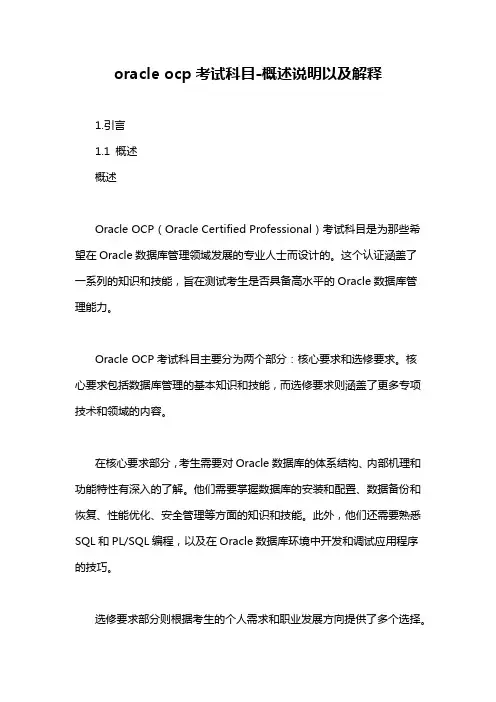
oracle ocp考试科目-概述说明以及解释1.引言1.1 概述概述Oracle OCP(Oracle Certified Professional)考试科目是为那些希望在Oracle数据库管理领域发展的专业人士而设计的。
这个认证涵盖了一系列的知识和技能,旨在测试考生是否具备高水平的Oracle数据库管理能力。
Oracle OCP考试科目主要分为两个部分:核心要求和选修要求。
核心要求包括数据库管理的基本知识和技能,而选修要求则涵盖了更多专项技术和领域的内容。
在核心要求部分,考生需要对Oracle数据库的体系结构、内部机理和功能特性有深入的了解。
他们需要掌握数据库的安装和配置、数据备份和恢复、性能优化、安全管理等方面的知识和技能。
此外,他们还需要熟悉SQL和PL/SQL编程,以及在Oracle数据库环境中开发和调试应用程序的技巧。
选修要求部分则根据考生的个人需求和职业发展方向提供了多个选择。
考生可以选择深入学习和掌握特定领域的知识和技术,如高可用性、数据仓库、分布式数据库等。
这些选修要求旨在让考生能够根据自己的兴趣和职业需求,更好地应对复杂的数据库管理和开发挑战。
通过Oracle OCP考试科目的学习和认证,考生可以证明自己具备了管理和开发Oracle数据库的能力。
这将为他们在职场上获得更多机会和提升空间,打下坚实的基础。
总之,Oracle OCP考试科目是一项重要的认证,它要求考生具备全面的Oracle数据库管理和开发技能。
通过此认证,考生可以展示他们的专业素养和实力,获得更好的职业发展机会。
1.2文章结构1.2 文章结构本文将围绕Oracle OCP考试的科目展开讨论。
首先,我们将概述Oracle OCP考试的背景和重要性。
接着,文章将分为三个主要部分,分别是引言、正文和结论。
在引言部分,我们将对Oracle OCP考试的整体概述进行阐述。
我们将介绍什么是Oracle OCP考试,它的目的和意义,并解释为什么这是对于那些希望在Oracle数据库管理领域取得认可的人来说必备的考试。
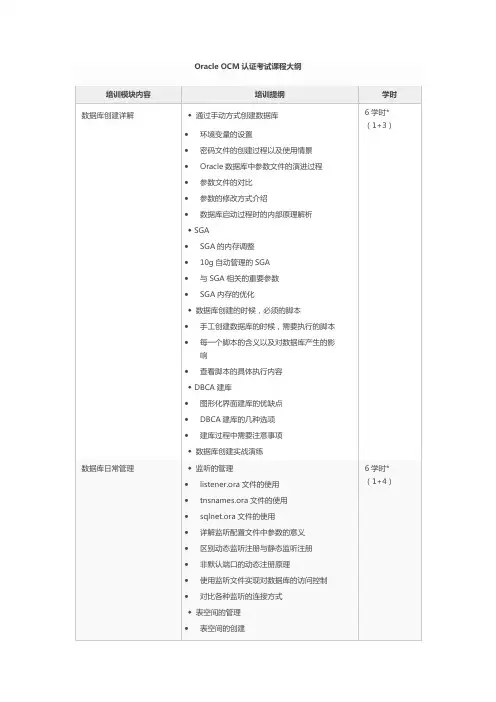
Oracle OCM认证考试课程大纲培训模块内容培训提纲学时6学时*(1+3)数据库创建详解◆通过手动方式创建数据库∙环境变量的设置∙密码文件的创建过程以及使用情景∙Oracle数据库中参数文件的演进过程∙参数文件的对比∙参数的修改方式介绍∙数据库启动过程时的内部原理解析◆ SGA∙SGA的内存调整∙10g自动管理的SGA∙与SGA相关的重要参数∙SGA内存的优化◆数据库创建的时候,必须的脚本∙手工创建数据库的时候,需要执行的脚本∙每一个脚本的含义以及对数据库产生的影响∙查看脚本的具体执行内容◆ DBCA建库∙图形化界面建库的优缺点∙DBCA建库的几种选项∙建库过程中需要注意事项◆数据库创建实战演练6学时*(1+4)数据库日常管理◆监听的管理∙listener.ora文件的使用∙tnsnames.ora文件的使用∙sqlnet.ora文件的使用∙详解监听配置文件中参数的意义∙区别动态监听注册与静态监听注册∙非默认端口的动态注册原理∙使用监听文件实现对数据库的访问控制∙对比各种监听的连接方式◆表空间的管理∙表空间的创建∙大文件表空间的使用,以及参数的介绍∙对比大文件表空间和小文件表空间∙表空间的扩展∙表空间的删除∙系统表空间的剖析∙表空间管理的演进:数据库管理表空间,本地管理表空间∙日志组的管理:添加日志组,为日志组添加成员等◆数据库默认属性的修改∙数据库的默认临时表空间,默认用户表空间的设置◆ Oracle数据库基于参数的优化◆控制文件∙控制文件的内容剖析∙控制文件的管理与备份∙控制文件的多路复用◆数据库的冷备∙冷备的概念∙冷备和热备的优缺点对比∙冷备的限制条件Enterprise Manager Grid Control◆ Grid Control体系结构◆部署Enterprise Manager Grid Control◆部署配置Enterprise Manager Grid ControlAgent◆使用Grid Control对数据库进行性能监控◆使用Grid Control创建表空间◆使用Grid Control对数据库进行日常运维∙创建job∙设置表空间警告阈值∙进行参数的调整◆使用Grid Control进行RMAN相关的备份∙创建Catalog∙配置Target∙一些参数的调整◆使用Grid Control创建分区表以及分区索引◆使用Grid Control创建含有特殊字段的表◆使用Grid Control 进行传输表空间的操作6学时*(1+3)◆ Grid Control的删除方法6学时*(1+3)备份恢复◆逻辑备份◆物理备份◆备份方式的对比◆ RMAN∙配置RMAN工作环境∙RMAN Catalog的原理∙配置恢复目录数据库∙RMAN 中常用参数的介绍以及作用∙压缩备份∙备份集与备份片的比较∙用RMAN备份/恢复数据库◆ Flashback闪回数据库技术∙Oracle数据库闪回技术浅析∙闪回技术分类∙对比各种闪回技术∙设置Flashback参数∙配置闪回区域∙监视Flashback数据库日志和统计信息∙执行Flashback Database操作∙配置闪回区域6学时*(1+3)数据库仓库◆对某种故障的处理∙问题所展示出来的现象描述∙所包含的原理∙该故障的解决方案◆系统表空间剖析◆物化视图∙物化视图的刷新及其原理∙物化视图的参数介绍∙物化视图的去重∙物化视图的跨库更新∙用物化视图进行备份∙物化视图重写◆ DB link的剖析◆ SQLLDR解析∙sqlldr中参数的含义∙sqlldr的使用方式∙案例演示sqlldr的使用过程∙sqlldr在使用过程中需要注意的知识点◆外部表∙外部表实现原理∙外部表的参数介绍∙对比sqlldr与datapump两种驱动方式∙跨库读取数据库运维◆传输表空间技术∙数据泵要点剖析∙表空间的状态以及各自的使用场景∙约束检查∙Directory的创建、授权∙EXPDP/IMPDP的参数透析∙用交互式命令行实现传输表空间技术◆分区技术∙分区表的创建∙分区表的分类∙分区索引的创建∙分区索引的分类∙全局索引与本地索引的对比∙对索引的维护◆ Oracle数据库的特殊字段∙几种常用的特殊字段∙每一种特殊字段的使用情景∙使用特殊字段的注意事项∙创建含有CLOB,BLOB字段的表∙创建含有时间戳字段的表∙创建引用rowid字段的表◆审计∙审计的用途∙细粒度审计的深入剖析∙触发审计的条件∙查看审计的触发记录◆索引监控6学时*(1.5+4)∙使用情景∙开启监控∙查看监控,了解索引的使用情况∙关闭监控◆闪回技术的案例精解∙案例:闪回查询∙案例:闪回删除∙案例:不完全恢复数据库优化◆检查点∙检查点的原理∙检查点的分类∙检查点对数据库性能的影响∙检查点的优化◆ Oracle内存优化∙优化共享池∙优化缓冲区高速缓存∙自动共享内存∙优化I/O∙优化PGA◆索引∙对各种索引的解析∙不同索引的使用情景∙索引的优缺点◆在线重定义技术∙内部原理∙对比在线重定义与Move操作◆优化工具介绍∙最根本的性能信息工具:数据库数据字典和动态性能视图∙Alert Log与Trace Files对性能故障诊断的帮助∙诊断性能问题的法宝:Statspack与AWR∙Statspack安装与使用∙AWR使用∙10g新增加的自动化监控、调优工具——ADDM 6学时*(1.5+4)◆ I/O优化∙数据库数据文件∙重做日志文件、∙归档文件的I/O性能特点分析和优化原则∙存储级的I/O性能考虑∙使用多DBWR进程增加I/O能力∙异步I/O的性能考虑∙LGWR与ARC进程的优化∙加速归档的方法◆竞争优化∙锁存器(LATCH)竞争优化∙锁竞争的解决∙回滚段竞争优化◆应用存储优化∙应用存储参数的优化∙选择合适的数据存储方法◆应用语句优化∙SQL语句的处理过程∙SQL语句解析的优化∙锁定执行计划Oracle Clusterware的安装◆简介6学时*(1+3)◆ Oracle Clusterware安装和配置∙Oracle RAC 安装说明∙执行RAC预安装任务∙手工建立信任关系的方法∙设置集群的环境变量∙安装Oracle Clusterware◆ Oracle software的安装◆ RAC软件安装∙安装和配置自动存储管理(ASM)∙安装Oracle数据库软件∙执行数据库创建前任务◆创建RAC数据库∙创建集群数据库∙执行创建数据库之后的任务◆在RAC中管理备份和恢复∙配置RAC数据库,以使用ARCHIVELOG模式和快速恢复区∙为RAC环境配置RMAN◆在RAC中的日常操作∙关闭数据库∙启动数据库∙表空间和数据库文件的维护∙日志信息的查看方式∙服务的运行状况Data Guard ◆ Oracle容灾技术Data Guard6学时*(1+3)∙Oracle Data Guard技术概述∙手工方式安装、配置和管理Oracle物理Data Guard∙使用Grid Control工具安装、配置和管理Oracle物理Data Guard∙使用Grid Control工具对Oracle DataGuard进行健康检查∙Oracle Data Guard三种数据保护模式之间比较及总结∙Oracle Data Guard主备Switchover切换演练∙OMF方式下Oracle Data Guard配置方式及特点∙Oracle Data Guard常见问题解析◆逻辑Data Guard的工作原理◆对比物理Data Guard与逻辑Data Guard◆对比Failover与Switchover备注:6学时*(1+3)代表每天的上课时间是6学时,括号内的第一个数字1代表知识点讲授是1天,第二个数字3代表攻击训练和冲刺辅导是3天。

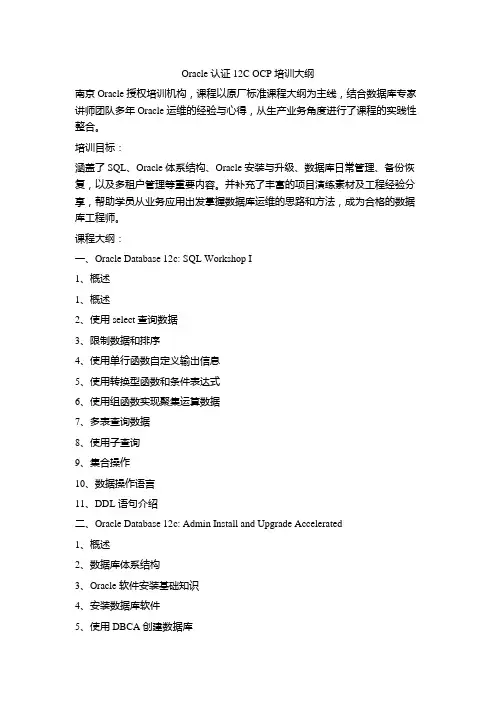
Oracle认证12C OCP培训大纲南京Oracle授权培训机构,课程以原厂标准课程大纲为主线,结合数据库专家讲师团队多年Oracle运维的经验与心得,从生产业务角度进行了课程的实践性整合。
培训目标:涵盖了SQL、Oracle体系结构、Oracle安装与升级、数据库日常管理、备份恢复,以及多租户管理等重要内容。
并补充了丰富的项目演练素材及工程经验分享,帮助学员从业务应用出发掌握数据库运维的思路和方法,成为合格的数据库工程师。
课程大纲:一、Oracle Database 12c: SQL Workshop I1、概述1、概述2、使用select查询数据3、限制数据和排序4、使用单行函数自定义输出信息5、使用转换型函数和条件表达式6、使用组函数实现聚集运算数据7、多表查询数据8、使用子查询9、集合操作10、数据操作语言11、DDL语句介绍二、Oracle Database 12c: Admin Install and Upgrade Accelerated1、概述2、数据库体系结构3、Oracle软件安装基础知识4、安装数据库软件5、使用DBCA创建数据库6、数据库管理工具7、管理数据库实例8、配置Oracle网络环境9、管理用户安全性10、管理数据库存储结构11、空间管理12、UNDO管理13、数据并发管理14、实施数据库审计15、备份恢复概念16、备份恢复配置17、执行备份……..三、Oracle Database 12c: Backup and Recovery Workshop1、概述2、入门3、恢复能力的配置4、使用RMAN恢复目录5、备份策略和术语6、执行备份7、备份的更多特性8、使用RMAN加密备份9、数据库故障的诊断10、还原和恢复的概念11、进行恢复I12、执行恢复II13、RAMN和Oracle安全备份14、执行磁带和磁盘的备份和还原15、使用闪回技术.........课程教材:原厂教材课程证书:学习结束,通过考试即获得原厂证书(OCA/OCP)课程日期:双休班、晚班、脱产班上课地点:南京市秦淮区中山东路300号长发中心A栋23楼。

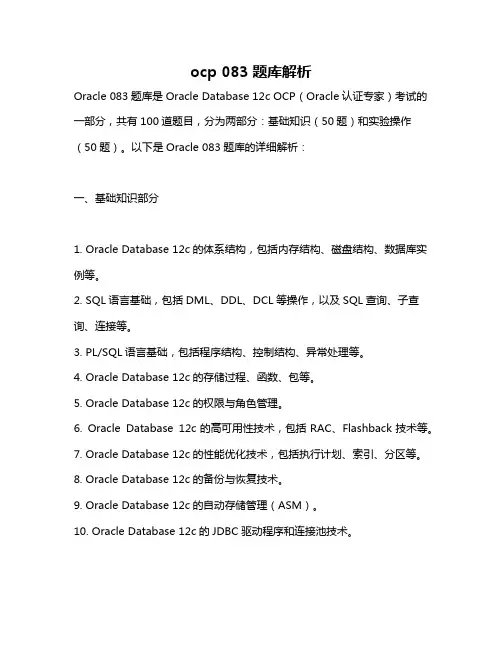
ocp 083题库解析Oracle 083题库是Oracle Database 12c OCP(Oracle认证专家)考试的一部分,共有100道题目,分为两部分:基础知识(50题)和实验操作(50题)。
以下是Oracle 083题库的详细解析:一、基础知识部分1. Oracle Database 12c的体系结构,包括内存结构、磁盘结构、数据库实例等。
2. SQL语言基础,包括DML、DDL、DCL等操作,以及SQL查询、子查询、连接等。
3. PL/SQL语言基础,包括程序结构、控制结构、异常处理等。
4. Oracle Database 12c的存储过程、函数、包等。
5. Oracle Database 12c的权限与角色管理。
6. Oracle Database 12c的高可用性技术,包括RAC、Flashback技术等。
7. Oracle Database 12c的性能优化技术,包括执行计划、索引、分区等。
8. Oracle Database 12c的备份与恢复技术。
9. Oracle Database 12c的自动存储管理(ASM)。
10. Oracle Database 12c的JDBC驱动程序和连接池技术。
二、实验操作部分1. 数据库的安装与配置。
2. 数据库的启动与关闭。
3. 数据库的备份与恢复。
4. SQL语句的执行计划分析。
5. PL/SQL程序的调试与优化。
6. 存储过程、函数和包的创建与优化。
7. 权限与角色的管理。
8. RAC环境的配置与测试。
9. Flashback技术的配置与测试。
10. ASM的配置与管理。
通过Oracle 083题库的考试,考生可以证明自己具备Oracle Database 12c的熟练技能和专业知识,为从事Oracle数据库相关的工作打下坚实的基础。
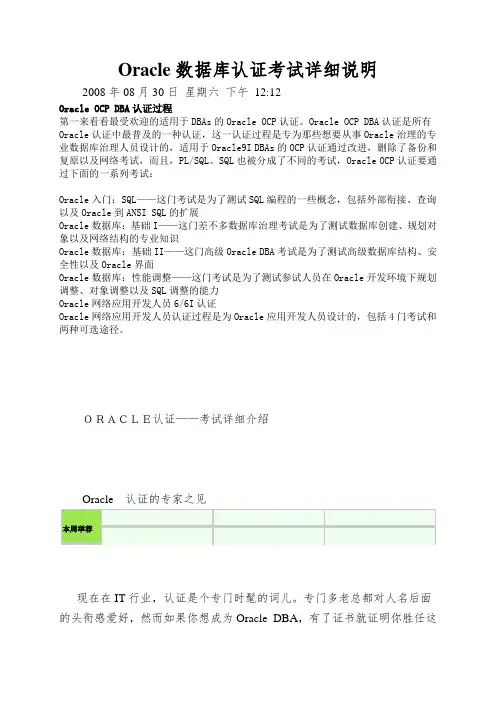
Oracle数据库认证考试详细说明2008年08月30日星期六下午12:12Oracle OCP DBA认证过程第一来看看最受欢迎的适用于DBAs的Oracle OCP认证。
Oracle OCP DBA认证是所有Oracle认证中最普及的一种认证,这一认证过程是专为那些想要从事Oracle治理的专业数据库治理人员设计的,适用于Oracle9I DBAs的OCP认证通过改进,删除了备份和复原以及网络考试,而且,PL/SQL、SQL也被分成了不同的考试,Oracle OCP认证要通过下面的一系列考试:Oracle入门:SQL——这门考试是为了测试SQL编程的一些概念,包括外部衔接、查询以及Oracle到ANSI SQL的扩展Oracle数据库:基础I——这门差不多数据库治理考试是为了测试数据库创建、规划对象以及网络结构的专业知识Oracle数据库:基础II——这门高级Oracle DBA考试是为了测试高级数据库结构、安全性以及Oracle界面Oracle数据库:性能调整——这门考试是为了测试参试人员在Oracle开发环境下规划调整、对象调整以及SQL调整的能力Oracle网络应用开发人员6/6I认证Oracle网络应用开发人员认证过程是为Oracle应用开发人员设计的,包括4门考试和两种可选途径。
ORACLE认证——考试详细介绍现在在IT行业,认证是个专门时髦的词儿。
专门多老总都对人名后面的头衔感爱好,然而如果你想成为Oracle DBA,有了证书就证明你胜任这份工作吗?或者讲它只是你的一张入门证。
本文中,我们就来分析一下OC P认证。
认证的价值第一来看看Oracle证书的价格,Oracle的每门认证考试是135美金,共有5门考试,所有的考试费用再加上一些其它费用(书、培训等等),要想通过Oracle认证考试本身确实是一笔不小的投资,然而,从今天的就业市场来看,得到的回报依旧值得的。
专门多人都期望在IT领域得到像Oracle DBA那样的高薪——年薪75,000$到140,000$。
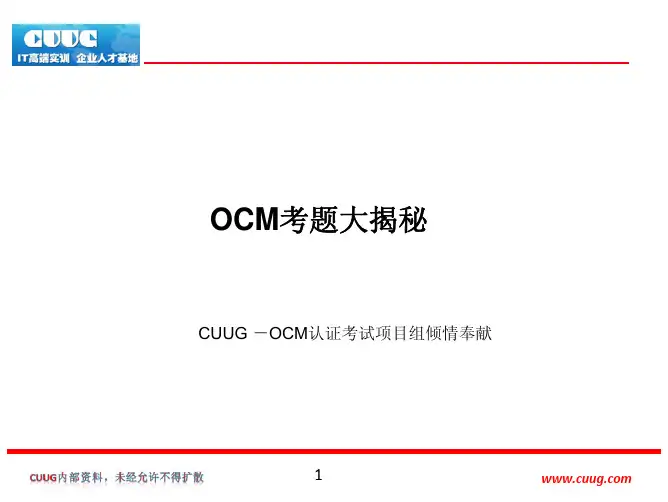
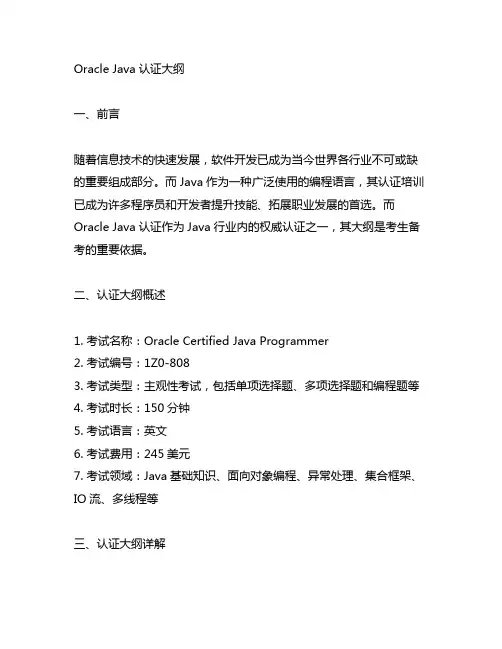
Oracle Java认证大纲一、前言随着信息技术的快速发展,软件开发已成为当今世界各行业不可或缺的重要组成部分。
而Java作为一种广泛使用的编程语言,其认证培训已成为许多程序员和开发者提升技能、拓展职业发展的首选。
而Oracle Java认证作为Java行业内的权威认证之一,其大纲是考生备考的重要依据。
二、认证大纲概述1. 考试名称:Oracle Certified Java Programmer2. 考试编号:1Z0-8083. 考试类型:主观性考试,包括单项选择题、多项选择题和编程题等4. 考试时长:150分钟5. 考试语言:英文6. 考试费用:245美元7. 考试领域:Java基础知识、面向对象编程、异常处理、集合框架、IO流、多线程等三、认证大纲详解1. Java基础知识- 了解Java评台及其特点- Java程序的编写和运行- 数据类型和变量- 运算符和表达式- 控制流程语句2. 面向对象编程- 类与对象的概念- 封装、继承、多态- 接口与抽象类- 泛型与集合3. 异常处理- 异常的概念与处理机制- 自定义异常类- 异常处理的最佳实践4. 集合框架- 集合与泛型- List、Set、Map接口及其实现类的使用 - 遍历集合与集合操作5. IO流- 文件操作- 对象序列化- NIO与传统IO的比较6. 多线程- 线程的创建与管理- 线程同步- 线程间通信机制- 并发与并行的概念四、备考建议1. 熟悉考试大纲:考生在备考前应对考试大纲的内容有一个清晰的了解,从而明确自己的备考方向。
2. 理论与实践结合:理论知识的掌握十分重要,但实际操作能力同样不可忽视。
建议考生在备考过程中注重实际编程练习,加深对知识的理解。
3. 寻找合适的学习资料:考生可以结合冠方推荐的教材以及网上的学习资料,制定个性化的学习计划。
4. 参加培训课程:有条件的考生可以选择参加相关的培训课程,培训班通常会有专业的老师进行系统的讲解和指导。
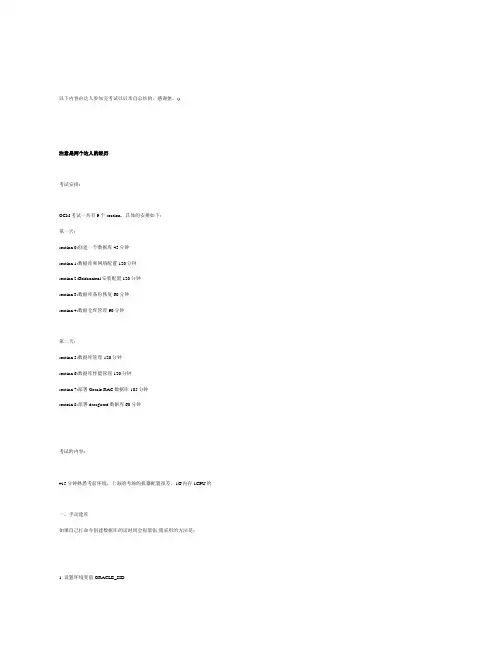
以下内容由达人参加完考试以后亲自总结的,感谢他。
:)注意是两个达人的经历.考试安排:OCM考试一共有9个section,具体的安排如下:第一天:section 0:创建一个数据库 45分钟section 1:数据库和网络配置 120分钟section 2:Gridcontrol安装配置 120分钟section 3:数据库备份恢复 60分钟section 4:数据仓库管理 90分钟第二天:section 5:数据库管理 120分钟section 6:数据库性能管理 120分钟section 7:部署Oracle RAC数据库 105分钟sectoin 8:部署dataguard数据库 60分钟考试的内容:#15分钟熟悉考前环境,上海的考场的机器配置很差,1G内存 1CPU的一、手动建库如果自己打命令创建数据库的话时间会很紧张,我采用的方法是:1. 设置环境变量ORACLE_SID参照考题中需要创建的数据库SID,设置操作系统环境变量,假设要求创建的数据库的SID是TEST。
2.手工创建如下目录:$ORACLE_BASE/admin/test/cdump$ORACLE_BASE/admin/test/bdump$ORACLE_BASE/admin/test/udump$ORACLE_BASE/admin/test/adump$ORACLE_BASE/oradata/test3. 创建最简单的initTEST.ora文件在$ORALCE_HOME/dbs下可以找到一份已经存在的init.ora文件,这是一份样本(在正式考试的机器上你也可以找到)。
打开这份文件可以看到很多被注释的行,让人烦躁,一行一行地修改这个文件比较耗时,使用下面的命令,把所有以#开头和所有的空行全部过滤掉,同时生成最简单的 initTEST.ora初始化参数文件。
$> cat init.ora | grep -v ^# | grep -v ^$ > initSID.ora然后修改该文件的db_name参数和control_files参数(控制文件放在哪里,需要多少份控制文件,在考题中会清楚地提出要求),其它的参数保持原状不需要修改。
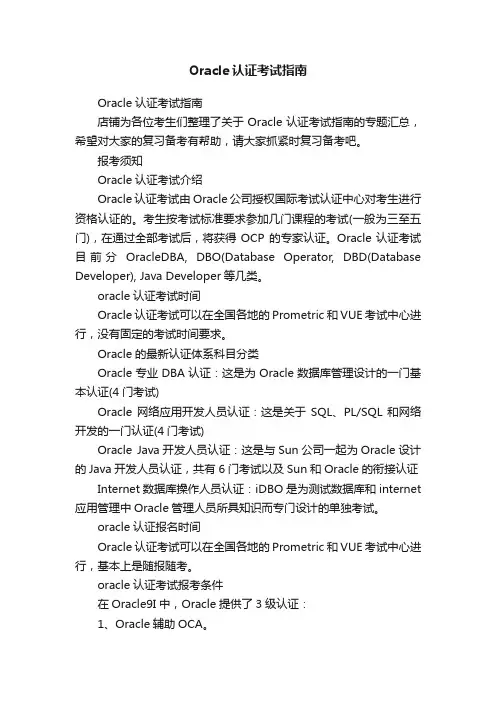
Oracle认证考试指南Oracle认证考试指南店铺为各位考生们整理了关于Oracle认证考试指南的专题汇总,希望对大家的复习备考有帮助,请大家抓紧时复习备考吧。
报考须知Oracle认证考试介绍Oracle认证考试由 Oracle公司授权国际考试认证中心对考生进行资格认证的。
考生按考试标准要求参加几门课程的考试(一般为三至五门),在通过全部考试后,将获得OCP 的专家认证。
Oracle认证考试目前分OracleDBA, DBO(Database Operator, DBD(Database Developer), Java Developer等几类。
oracle认证考试时间Oracle认证考试可以在全国各地的Prometric和VUE考试中心进行,没有固定的考试时间要求。
Oracle的最新认证体系科目分类Oracle专业DBA认证:这是为Oracle数据库管理设计的一门基本认证(4门考试)Oracle网络应用开发人员认证:这是关于SQL、PL/SQL和网络开发的一门认证(4门考试)Oracle Java开发人员认证:这是与Sun公司一起为Oracle设计的Java开发人员认证,共有6门考试以及Sun和Oracle的衔接认证Internet数据库操作人员认证:iDBO是为测试数据库和internet 应用管理中Oracle管理人员所具知识而专门设计的单独考试。
oracle认证报名时间Oracle认证考试可以在全国各地的Prometric和VUE考试中心进行,基本上是随报随考。
oracle认证考试报考条件在Oracle9I中,Oracle提供了3级认证:1、Oracle辅助OCA。
2、Oracle9I专业认证OCP。
3、Oracle专家级认证OCM。
oracle认证考试费用1、收费标准:OCA:1780元/人(含以上2门课程中除认证考试费用以外的一切费用。
)国际认证考试费:1250元/门/次。
2、为学员提供在线培训主教材及独家开发且具独立知识产权的多媒体学习课件光盘(1张)。
oracle12cocm考试范围General Database and Network AdministrationCreate and manage pluggable databasesAdminister users, roles, and privilegesConfigure the network environment to allow connections to multiple databases ?Administer database configuration files Configure shared serverManage network file directoriesManage Database AvailabilityInstall the EM Cloud Control agent?Configure recovery catalogConfigure RMANPerform a full database backupConfigure and monitor Flashback DatabaseData Warehouse ManagementManage database linksManage a fast refreshable materialized viewCreate a plug-in tablespace by using the transportable tablespace featureOptimize star queriesConfigure parallel executionApply a PatchConfigure Automatic Data Optimization, In-Row Archiving, and Temporal Validity ?Manage external tablesData ManagementManage additional buffer cacheOptimize space usage for the LOB dataManage an encrypted tablespaceManage schema dataManage partitioned tablesSet up Fine-Grained AuditingConfigure the database to retrieve all previous versions of the table rowsPerformance ManagementConfigure the Resource ManagerTune SQL statementsUse real application testingManage SQL Plan baselinesCapture performance statisticsTune an instanceConfigure and manage result cacheManage extended statisticsCreate and manage partitioned indexesControl CPU use for Oracle InstancesConfigure and manage "In Memory" featuresData GuardAdminister a Data Guard environmentCreate a physical standby databaseConfigure a standby database for testingConfigure a standby database to apply redoConfigure a standby database to use for reportingConfigure fast start failoverManage DDL in a Data Guard environmentGrid InfrastructureInstall Oracle Grid InfrastructureCreate ASM Disk GroupsCreate and manage ASM instancesConfigure ASM Cloud File System (ACFS)Administer Oracle ClusterwareManage Flex Clusters and Flex ASMReal Application Cluster DatabaseInstall Oracle Database softwareCreate a Real Application Clusters (RAC) databaseConfigure Database ServicesAdminister Oracle RAC databases on one or more cluster nodes。
Oracle 应知应会Oracle是数据库厂商中的龙头老大,为世界范围的企业提供数据库、工具和应用软件产品,以及相关的咨询、教育和支持服务,年收入为108亿多美元,总部设于加利福尼亚州。
Oracle 在代表着未来数据库应用发展方向的现代关系型数据库市场中占据了39.8%的市场份额,在“财富100家”企业的市场份额高达51%,已无可争议地成为企业级数据库产品的首选。
Oracle大学(Oracle University)是Orcale公司专门负责培训业务的部门,这些专业的课程使受训者更快地掌握Oracle技术。
Oracle认证一直被认为是最高等级的IT认证之一,更是高端中的高端。
因此,获得Oracle认证就如同获得大企业的职位绿卡,能够迅速踏入金领阶层。
另一方面,Oracle的培训体系相当先进,它提供了高质量原厂培训课程。
针对最新Oracle 9i的认证体系包括三个层次:初级的有Oracle认证专员,英文:Oracle Certified Associate (OCA);较高层次的Oracle认证专家,英文:Oracle Certified Professional (OCP);最高层次的Oracle认证资深专家,英文:Oracle Certified Master (OCM)。
其中尤以OCP Oracle9i DBA认证最受欢迎。
Oracle认证专家(OCP)专家级技能和结束知识考试,通过这种考试之后,说明可以管理大型数据库,或者能够开发可以部署到整个企业的强大应用。
要成为OCP,必须先获得OCA证书,然后才能参加OCP要求的其他考试。
参加OCP认证的学员必须至少在Oracle大学或者其授权培训中心学习1门课程才能获得OCP证书。
这些考试必须在授权的Prometric考试中心进行。
目前OCP认证考试分为- Database Administrator: 数据库管理员考试认证(OCP Oracle9i DBA)- Database Operator: 数据库操作员认证考试- Database Developer: 数据库开发员认证考试- Java Developer: Oracle Java 开发人员考试我们开展的是OCP Oracle9i DBA课程。
Oracle Database 11g: SQL Fundamentals I (1Z0-051)Retrieving Data Using the SQL SELECT Statement∙List the capabilities of SQL SELECT statements∙Execute a basic SELECT statementRestricting and Sorting Data∙Limit the rows that are retrieved by a query∙Sort the rows that are retrieved by a query∙Use ampersand substitution to restrict and sort output at runtimeUsing Single-Row Functions to Customize Output∙Describe various types of functions available in SQL∙Use character, number, and date functions in SELECT statementsUsing Conversion Functions and Conditional Expressions∙Describe various types of conversion functions that are available in SQL∙Use the TO_CHAR, TO_NUMBER, and TO_DATE conversion functions∙Apply conditional expressions in a SELECT statementReporting Aggregated Data Using the Group Functions∙Identify the available group functions∙Describe the use of group functions∙Group data by using the GROUP BY clause∙Include or exclude grouped rows by using the HA VING clauseDisplaying Data from Multiple Tables∙Write SELECT statements to access data from more than one table using equijoins and nonequijoins∙Join a table to itself by using a self-join∙View data that generally does not meet a join condition by using outer joins∙Generate a Cartesian product of all rows from two or more tablesUsing Subqueries to Solve Queries∙Define subqueries∙Describe the types of problems that the subqueries can solve∙List the types of subqueries∙Write single-row and multiple-row subqueriesUsing the Set Operators∙Describe set operators∙Use a set operator to combine multiple queries into a single query∙Control the order of rows returnedManipulating Data∙Describe each data manipulation language (DML) statement∙Insert rows into a table∙Update rows in a table∙Delete rows from a table∙Control transactionsUsing DDL Statements to Create and Manage Tables∙Categorize the main database objects∙Review the table structure∙List the data types that are available for columns∙Create a simple table∙Explain how constraints are created at the time of table creation∙Describe how schema objects workCreating Other Schema Objects∙Create simple and complex views∙Retrieve data from views∙Create, maintain, and use sequences∙Create and maintain indexes∙Create private and public synonymsOracle Database 11g: Administration I (1Z0-052)Exploring the Oracle Database Architecture∙Explain the Memory Structures∙Describe the Process Structures∙Overview of Storage StructuresPreparing the Database Environment∙Identify the tools for Administering an Oracle Database∙Plan an Oracle Database installation∙Install the Oracle software by using Oracle Universal Installer (OUI) Creating an Oracle Database∙Create a database by using the Database Configuration Assistant (DBCA) Managing the Oracle Instance∙Setting database initialization parameters∙Describe the stages of database startup and shutdown∙Using alert log and trace files∙Using data dictionary and dynamic performance viewsConfiguring the Oracle Network Environment∙Configure and Manage the Oracle Network∙Using the Oracle Shared Server architectureManaging Database Storage Structures∙Overview of tablespace and datafiles∙Create and manage tablespaces∙Space management in tablespacesAdministering User Security∙Create and manage database user accounts∙Grant and revoke privileges∙Create and manage roles∙Create and manage profilesManaging Data and Concurrency∙Monitor and resolve locking conflictsManaging Undo Data∙Overview of Undo∙Transactions and undo data∙Managing undoImplementing Oracle Database Security∙Database Security and Principle of Least Privilege∙Work with Standard Database AuditingDatabase Maintenance∙Use and manage optimizer statistics∙Use and manage Automatic Workload Repository (AWR)∙Use advisory framework∙Manage Alerts and ThresholdsPerformance Management∙Use Automatic Memory Management∙Use Memory Advisors∙Troubleshoot invalid and unusable objectsIntelligent Infrastructure Enhancements∙Use the Enterprise Manager Support Workbench∙Managing PatchesBackup and Recovery Concepts∙Identify the types of failure that can occur in an Oracle database∙Describe ways to tune instance recovery∙Identify the importance of checkpoints, redo log files, and archived log files∙Overview of flash recovery area∙Configure ARCHIVELOG modePerforming Database Backups∙Create consistent database backups∙Back up your database without shutting it down∙Create incremental backups∙Automate database backups∙Manage backups, view backup reports and monitor the flash recovery areaPerforming Database Recovery∙Overview of Data Recovery Advisor∙Use Data Recovery Advisor to Perform recovery (Control file, Redo log file and Data file) Moving Data∙Describe and use methods to move data (Directory objects, SQL*Loader, External Tables) ∙Explain the general architecture of Oracle Data Pump∙Use Data Pump Export and Import to move data between Oracle databasesOracle Database 11g: Administration II (1Z0-053)Database Architecture and ASM∙Describe Automatic Storage Management (ASM)∙Set up initialization parameter files for ASM and database instances∙Start up and shut down ASM instances∙Administer ASM disk groupsConfiguring for Recoverability∙Configure multiple archive log file destinations to increase availability∙Define, apply and use a retention policy∙Configure the Flash Recovery Area∙Use Flash Recovery AreaUsing the RMAN Recovery Catalog∙Identify situations that require RMAN recovery catalog∙Create and configure a recovery catalog∙Synchronize the recovery catalog∙Create and Use RMAN stored scripts∙Back up the recovery catalog∙Create and use a virtual private catalogConfiguring Backup Specifications∙Configure backup settings∙Allocate channels to use in backing up∙Configure backup optimizationUsing RMAN to Create Backups∙Create image file backups∙Create a whole database backup∙Enable fast incremental backup∙Create duplex backup and back up backup sets∙Create an archival backup for long-term retention∙Create a multisection, compressed and encrypted backup∙Report on and maintain backupsPerforming User-Managed Backup and Recovery∙Recover from a lost TEMP file∙Recover from a lost redo log group∙Recover from the loss of password file∙Perform user-managed complete database recovery∙Perform user-managed incomplete database recovery∙Perform user-managed and server managed backups∙Identify the need of backup mode∙Back up and recover a control fileUsing RMAN to Perform Recovery∙Perform complete recovery from a critical or noncritical data file loss using RMAN ∙Perform incomplete recovery using RMAN∙Recover using incrementally updated backups∙Switch to image copies for fast recovery∙Restore a database onto a new host∙Recover using a backup control file∙Perform Disaster recoveryUsing RMAN to Duplicate a Database∙Creating a duplicate database∙Using a duplicate databasePerforming Tablespace Point-in-Time Recovery∙Identify the situations that require TSPITR∙Perform automated TSPITRMonitoring and Tuning RMAN∙Monitoring RMAN sessions and jobs∙Tuning RMAN∙Configure RMAN for Asynchronous I/OUsing Flashback Technology∙Restore dropped tables from the recycle bin∙Perform Flashback Query∙Use Flashback TransactionAdditional Flashback Operations∙Perform Flashback Table operations∙Configure, Monitor Flashback Database and Perform Flashback Database operations ∙Set up and use a Flashback Data ArchiveDiagnosing the Database∙Set up Automatic Diagnostic Repository∙Using Support Workbench∙Perform Block Media RecoveryManaging Memory∙Implement Automatic Memory Management∙Manually configure SGA parameters∙Configure automatic PGA memory managementManaging Database Performance∙Use the SQL Tuning Advisor∙Use the SQL Access Advisor to tune a workload∙Understand Database ReplaySpace Management∙Manage resumable space allocation∙Describe the concepts of transportable tablespaces and databases∙Reclaim wasted space from tables and indexes by using the segment shrink functionality Managing Resources∙Understand the database resource manager∙Create and use Database Resource Manager ComponentsAutomating Tasks with the Scheduler∙Create a job, program, and schedule∙Use a time-based or event-based schedule for executing Scheduler jobs∙Create lightweight jobs∙Use job chains to perform a series of related tasksAdministering the Scheduler∙Create Windows and Job Classes∙Use advanced Scheduler concepts to prioritize jobsOracle Database 11g Certified Master ExamServer Configuration∙Create the database∙Determine and set sizing parameters for database structures∙Create and manage temporary, permanent, and undo tablespaces∙Stripe data files across multiple physical devices and locations∙Configure the database environment to support optimal data access performance∙Create and manage database configuration files∙Create and manage bigfile tablespaces∙Create and Manage a tablespace that uses NFS mounted file system file∙Create and manage multiple network configuration files∙Create and configure a listener∙Configure the database instance to support shared server connections∙Set up network tracing∙Manage Oracle network processes∙Configure the network environment to allow connections to multiple databases∙Use configurationless connections∙Use OPatch to install a patch∙Use Grid Infrastructure to manage oracle databases and other resources∙Use Enterprise Manager Configuration Assistant(EMCA) utilityEnterprise Manager Grid Control∙Install and Patch Enterprise Manager Grid Control software∙Configure the Enterprise Manager repository∙Create Enterprise Manager Grid Control users∙Use Enterprise Manager to modify a database configuration∙Configure Enterprise Manager to modify database availability∙Create and manage jobs∙Create and monitor alerts∙Create notifications∙Implement Grid Control and Database Control∙Choose the appropriate tablespace type for the intended use∙Create Scheduler jobs∙Create schedules∙Assign jobs to windows∙Create programs∙Create job classes∙Install the Enterprise Manager Grid Control infrastructure∙Deploy Enterprise Manager Grid Control agents∙Configure Grid Control for business requirementsManaging Database Availability∙Mantain recovery catalogs∙Configure Recovery Manager∙Use Recovery Manager to perform database backups∙Use Recover Manager to perform complete database restore and recovery operations∙Configure RMAN∙Create different types of RMAN backups to cater for different performance and retention requirements∙Set Flashback Database parameters∙Configure a Fast Recovery Area∙Perform various recovery operations using Flashback technologyData Management∙Manage Materialized Views to improve rewrite and refresh performance∙Configure and manage distributed materialized views∙Create and Manage encrypted tablespaces∙Manage Transport of tablespaces across platforms∙Configure a schema to support a star transformation query∙Administer external tables∙Implement Data Pump export and import jobs for data transfer∙Implement Data Pump to and from remote databases∙Configure and use parallel execution for queries∙Use SQL*Loader∙Administer, manage and tune parallel executionData Warehouse Management∙Administer partitioned tables and indexes using appropriate methods and keys∙Perform partition maintenance operations∙Maintain indexes on a partitioned table∙Implement securefile LOB∙Create and manage LOB segments∙Implement fine-grained access control∙Create and manage contexts∙Administer flashback data archive and schema evolutionPerformance Management∙Administer Resource Manager∙Use Result Cache∙Use multi column statistics∙Gather statistics on a specific table without invalidating cursors∙Use partitioned indexes∙Administer and tune schema object to support various access methods∙Interpret execution plan∙Use SQL tuning tools and features∙Use SQL Tuning Advisor∙Use SQL Access Advisor∙Use SQL Performance Analyzer∙Configure baseline templates∙Use SQL Plan Management feature∙Implement instance cagingGrid Infrastructure and ASM∙Install Oracle Grid Infrastructure∙Create ASM Disk Groups∙Create and manage as ASM instance∙Implement ASM failure groups∙Creating ACFS File System∙Start, stop, configure and administer Oracle Grid InfrastructureReal Application Clusters∙Install the Oracle Database 11gR2 software∙Configure ASM for the shared disks and create a clustered database∙Configure archiving∙Configure services using both Manual and Policy Managed methodsData Guard∙Create Physical Standby Database with real-time apply∙Configure the data guard environment to reduce overheads of fast incremental backups on the primary database∙Configure the Observer∙Switchover and switch back∙Configure connect time failover∙Convert the standby to a snapshot standby∙Configure archivelog deletion policy for the Dataguard configuration。
General Database and Network Administration
∙Create and manage pluggable databases
∙Administer users, roles, and privileges
∙Configure the network environment to allow connections to multiple databases ∙Administer database configuration files
∙Configure shared server
∙Manage network file directories
Manage Database Availability
∙Install the EM Cloud Control agent?Configure recovery catalog
∙Configure RMAN
∙Perform a full database backup
∙Configure and monitor Flashback Database
Data Warehouse Management
∙Manage database links
∙Manage a fast refreshable materialized view
∙Create a plug-in tablespace by using the transportable tablespace feature
∙Optimize star queries
∙Configure parallel execution
∙Apply a Patch
∙Configure Automatic Data Optimization, In-Row Archiving, and Temporal Validity ∙Manage external tables
Data Management
∙Manage additional buffer cache
∙Optimize space usage for the LOB data
∙Manage an encrypted tablespace
∙Manage schema data
∙Manage partitioned tables
∙Set up Fine-Grained Auditing
∙Configure the database to retrieve all previous versions of the table rows
Performance Management
∙Configure the Resource Manager
∙Tune SQL statements
∙Use real application testing
∙Manage SQL Plan baselines
∙Capture performance statistics
∙Tune an instance
∙Configure and manage result cache
∙Manage extended statistics
∙Create and manage partitioned indexes
∙Control CPU use for Oracle Instances
∙Configure and manage "In Memory" features
Data Guard
∙Administer a Data Guard environment
∙Create a physical standby database
∙Configure a standby database for testing
∙Configure a standby database to apply redo
∙Configure a standby database to use for reporting
∙Configure fast start failover
∙Manage DDL in a Data Guard environment
Grid Infrastructure
∙Install Oracle Grid Infrastructure
∙Create ASM Disk Groups
∙Create and manage ASM instances
∙Configure ASM Cloud File System (ACFS)
∙Administer Oracle Clusterware
∙Manage Flex Clusters and Flex ASM
Real Application Cluster Database
∙Install Oracle Database software
∙Create a Real Application Clusters (RAC) database
∙Configure Database Services
∙Administer Oracle RAC databases on one or more cluster nodes。